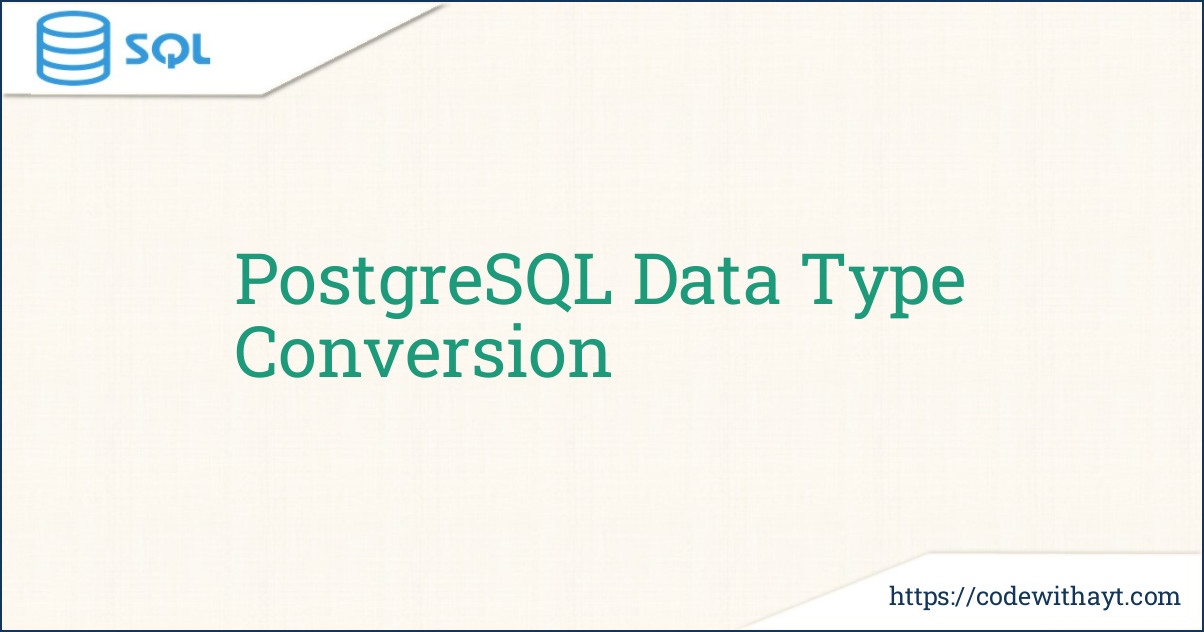PostgreSQL is one of the most powerful and open-source relational database systems. It comes with a wide range of data types, and in many real-world applications, you may need to convert data from one type to another. This blog post is a simple, human-friendly guide on PostgreSQL Data Type Conversion, with clear examples. Whether you're a beginner or someone looking to refresh your knowledge, this post has got you covered.
What is Data Type Conversion?
Data type conversion is the process of changing a value from one data type to another. In PostgreSQL, you might need to convert an integer to a string, a string to a date, or a float to an integer, depending on your requirements.
For example:
-
Changing
100(integer) to'100'(text) -
Converting
'2024-01-01'(text) to aDATE -
Changing
99.99(numeric) to99(integer)
This helps ensure the correct data type is used for calculations, comparisons, and storage.
Why is Data Type Conversion Important?
Data type conversion is important for several reasons:
-
Data Accuracy: Prevents errors and ensures correct data representation.
-
Query Flexibility: Allows flexible filtering, joining, and formatting of data.
-
Application Compatibility: Matches backend or frontend data types for smooth integration.
-
Performance Optimization: Reduces unnecessary processing when the right type is used.
Types of Data Type Conversion in PostgreSQL
PostgreSQL offers two main ways to convert data types:
1. Implicit Conversion
PostgreSQL automatically converts one data type to another if it's safe to do so. This is called implicit conversion.
Example:
SELECT '10' + 5;PostgreSQL converts the string '10' to an integer automatically. The result is 15.
But this only works when it's safe and unambiguous. If not, PostgreSQL throws an error.
2. Explicit Conversion (Casting)
When PostgreSQL doesn’t convert automatically, you need to do it manually using casting.
There are two ways to explicitly cast:
-
Using the
CAST()function -
Using the double colon
::operator
How to Convert Data Types in PostgreSQL (With Examples)
Let’s walk through common data type conversions using both methods.
1. Convert String to Integer
SELECT CAST('123' AS INTEGER);
-- or
SELECT '123'::INTEGER;Output: 123 (as an integer)
This is useful when you get numbers in text format from an API or CSV file.
2. Convert Integer to String
SELECT CAST(456 AS TEXT);
-- or
SELECT 456::TEXT;Output: '456' (as text)
Helps when displaying numbers in a UI or logging.
3. Convert String to Date
SELECT CAST('2025-06-01' AS DATE);
-- or
SELECT '2025-06-01'::DATE;Output: 2025-06-01
Perfect for importing date values from strings.
4. Convert Date to String
SELECT CAST(CURRENT_DATE AS TEXT);
-- or
SELECT CURRENT_DATE::TEXT;Output: '2025-06-02' (or today's date)
Useful when exporting data or sending to external systems.
5. Convert Float to Integer
SELECT CAST(45.78 AS INTEGER);
-- or
SELECT 45.78::INTEGER;Output: 45
Note: This truncates the decimal part. It doesn’t round it.
6. Convert Integer to Boolean
SELECT CAST(1 AS BOOLEAN), CAST(0 AS BOOLEAN);
-- or
SELECT 1::BOOLEAN, 0::BOOLEAN;Output: true, false
Only 0 is false, all other non-zero values are true.
Common Mistakes and How to Avoid Them
1. Invalid Format Strings
SELECT 'abc'::INTEGER;
-- ERROR: invalid input syntax for integer: "abc"Always make sure the string is convertible to the desired type.
2. Loss of Precision
SELECT 123.99::INTEGER;
-- Output: 123Casting a float to an integer removes the decimal part. Use ROUND() if you want to round instead.
3. Wrong Date Format
SELECT '06-02-2025'::DATE;
-- Might work or fail depending on localeUse ISO format YYYY-MM-DD for best compatibility.
Using Type Conversion in Real Queries
Let’s say you have a table users:
CREATE TABLE users (
id SERIAL,
name TEXT,
age TEXT,
signup_date TEXT
);You want to:
-
Calculate average age
-
Sort by signup date
You’ll need to convert the text fields:
SELECT AVG(age::INTEGER) FROM users;
SELECT * FROM users ORDER BY signup_date::DATE DESC;Best Practices
-
Always validate data before conversion to avoid errors.
-
Prefer explicit casting in complex queries for better readability.
-
Use standard formats like
YYYY-MM-DDfor dates and ISO 8601 for timestamps. -
Be aware of performance; unnecessary conversions can slow down queries.
-
Handle null values carefully. For example:
SELECT NULL::INTEGER; -- Result: NULL (safe)
Summary
PostgreSQL makes it easy to convert between data types, giving you flexibility and power in handling different kinds of data. Here’s what we covered:
-
Implicit vs. Explicit conversions
-
Casting with
CAST()and:: -
Real-world examples for strings, numbers, dates, and booleans
-
Common pitfalls and how to avoid them
-
Best practices for safe and efficient type conversion
If you’re working with PostgreSQL databases, mastering data type conversion will help you write cleaner, safer, and more powerful queries.



